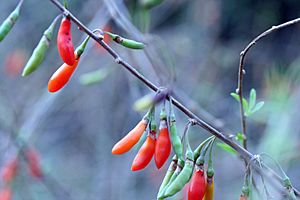Chinese boxthorn facts for kids
Quick facts for kids Chinese boxthorn |
|
|---|---|
 |
|
| Lycium chinense fruits | |
| Scientific classification | |
| Genus: |
Lycium
|
| Species: |
chinense
|
| Synonyms | |
|
|
Lycium chinense is a type of shrub often called Chinese wolfberry or Chinese boxthorn. It belongs to the nightshade family, just like tomatoes and potatoes. This plant is one of two species that produce the famous goji berry, also known as wolfberry. There are two main types of L. chinense: L. chinense var. chinense and L. chinense var. potaninii.
Contents
About the Plant
Wolfberry plants are deciduous woody shrubs. This means they are woody plants that lose their leaves every autumn. They usually grow about 1 to 3 meters (3 to 10 feet) tall. Their stems have many branches that are pale gray, thin, and can be curved or hang down. These branches also have small thorns, usually about 0.5 to 2 centimeters (0.2 to 0.8 inches) long.
Leaves
The leaves of Lycium chinense grow on the shoots. They can appear alone or in small groups of 2 to 4 leaves. Their shape can vary, but they are usually oval, diamond-shaped, or long and narrow. They are typically 1.5 to 5 centimeters (0.6 to 2 inches) long and 0.5 to 2.5 centimeters (0.2 to 1 inch) wide. However, in plants grown by people, they can be much larger, up to 10 centimeters (4 inches) long and 4 centimeters (1.6 inches) wide.
Flowers
The flowers grow in groups of one to three where the leaves meet the stem. Each flower has a small stem about 1 to 2 centimeters (0.4 to 0.8 inches) long. The base of the flower, called the calyx, is bell-shaped or tube-shaped. It eventually splits as the berry grows. The petals of the flower are lavender or light purple. They form a tube that is about 9 to 14 millimeters (0.35 to 0.55 inches) wide. The flower has five or six lobes (parts) that are longer than the tube and have short hairs on their edges. Inside the flower are the stamens, which are the male parts.
Fruit and Seeds
Lycium chinense produces a bright orange-red berry. The berries are usually oval or oblong in shape. They are about 7 to 15 millimeters (0.3 to 0.6 inches) long and 5 to 8 millimeters (0.2 to 0.3 inches) wide. However, in cultivated plants, they can grow up to 22 millimeters (0.9 inches) long and 10 millimeters (0.4 inches) wide.
Inside the berry are flat, yellow seeds. These seeds are about 2.5 to 3 millimeters (0.1 inches) wide. The number of seeds in each berry can be very different, from 10 to 60, depending on the plant type and fruit size. The berries become ripe from July to October in the Northern Hemisphere.
Plant Health
This plant can sometimes get a disease caused by a tiny organism called Peronospora lycii. This organism is a type of oomycete, which is similar to a fungus.
How People Use It
The berries of Lycium chinense are often used to make a special tea. You can make goji tea by pouring hot water over the dried fruits. For hundreds of years, this plant has been used in traditional Chinese medicine. People have used it for various health purposes.
Plant Chemistry
The fruits of Lycium chinense contain many helpful natural substances. These include polysaccharides, which are types of complex sugars. They also have carotenoids, which give the berries their bright color, and flavonoids, which are plant compounds. A key flavonoid found in the fruit is Rutin. The main carotenoid is a type of zeaxanthin. The roots, root bark, and leaves of the plant also contain many other natural compounds. For example, Citric acid is a major acid found in the leaves.
Gallery
See also
 In Spanish: Baya de goji para niños
In Spanish: Baya de goji para niños







